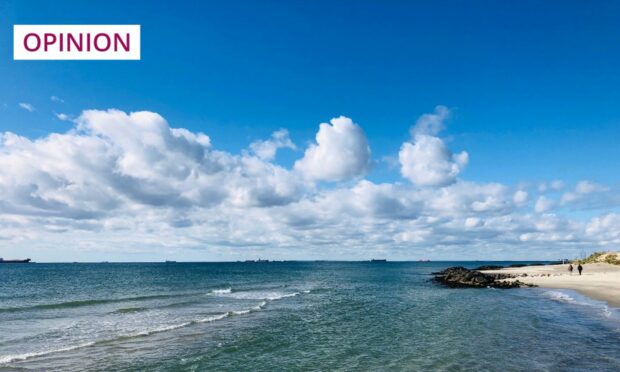I’m in Skagen, Denmark, at the Skagen Odde.
The Odde is a sandy peninsula, a long finger, that reaches out between the Kattegat and Skaggerrak seas, at the northern end of the country. The sand dunes are covered in purple heather. When you stand at Grenen beach, near the tip of the land, you see a foamy white line in the sea, where the Baltic and the North Seas meet.
I cannot pretend that I understand the science of the phenomenon. The currents and density and colours of the water clash up against each other, and appear to stand deadlocked.
Above us, the sky is clouded, the Scottish summer weather having drifted across the North Sea, catching up with us after we landed at Aalborg. I look east, toward the Kattegat and the Baltic Sea, a balmy breeze going over my shoulder.
Growing up on the Buchan coast, we’d describe anything colder than a normal cold day – of which there were plenty – as “baltic”. Today, it doesn’t strike me as any colder than the coasts of Aberdeen or Peterhead or Banff, but it has been known to freeze over completely in the coldest winters.
Back in the UK, we’ve recently undergone quite the heatwave. Much of June was characterised by beautiful blue and cloudless skies, and days of 20C and higher, until the rumbles of thunder and rain rolled in, and the Scottish summer recommenced in a more traditional fashion. The wet stuff has piled down since, but it has still been hot and humid.

The real heatwave was in the water, though. Global sea surfaces recorded their warmest April and May on record, going back to 1850. Then, in June, the US National Oceanic and Atmospheric Administration reported that parts of the North Sea were in an “extreme heatwave”, at 5C above usual averages on June 17. Indeed, June has become the hottest on record in the UK, both on sea and land.
We try to fight to control the changing climate. The Labour leader, Keir Starmer, proposed ending all new licences in the North Sea, if his party are elected in 2024. It has prompted backlash in Aberdeen from all quarters, understandably, with criticism from the business community, public and politicians. Indeed, long-standing Labour councillor and former Lord Provost Barney Crockett quit the party over Keir’s pledge.
It’s a hard conversation to have, for sure, in a city powered by the energy sector.
A place that doesn’t feel too far from home
Across the Kattegat, at the forefront of the Baltic, the waters push up from the south to the Skagerrak. The Kattegat was, at one point, considered one of the first marine ecological “dead zones”, hypoxic areas in the world’s oceans, where environmental damage had become out of control. These are some of the busiest shipping lanes in the world.
Skagen itself is a bustling fishing harbour, one of the largest in Denmark, despite the relatively small size of the town. The large port of Frederikshavn is a little farther to the south – a huge industrial harbour. It’s an area of the world not at all unlike the ones I call home.
Here, the Danish government and the EU attempted to combat the Kattegat dead zone, with some success, thanks to successive action plans.
Doing both economy and environment justice is key
It’s difficult to see how Aberdeen might resolve its dependence on the energy sector, even as the North Sea heats up. So many depend on the offshore industry for their livelihood, and the idea of transition to renewables full time is nerve-wracking – even if a Great British Clean Energy Company, as touted by Labour, is based in the city. The threat of economic decline might always seem more immediate.
That even remains the case while the impacts of climate change are felt evermore directly. In June, we teetered on the precipice of a water shortage over the whole of Scotland, due to the extended dry weather, although the rain fell at just the right time.
We also saw continual wildfire risk notices, with an area the size of much of Aberdeen city centre burning in Cannich in the Highlands. It became the biggest wildfire in the UK in memory. Mother Nature’s challenges will not go away, and will become all the more threatening, as we continue to burn through carbon.
As with policies on marine conservation plans, or bottle return schemes, however, it’s important we get the future policies on North Sea oil and gas correct, and achieve the correct balance between the economy and the environment, so that prosperity can be achieved in both columns by the coming generations.
I stand in the sand in Skagen and keep watching the Kattegat and the Skagerrak; the North Sea and the Baltic, clashing and writhing, frothing and foaming, both currents borne against one another. I understand how hard it can be to go against a tide, once one has momentum.
Colin Farquhar works as a creative spaces manager and film programmer in the north-east culture sector

